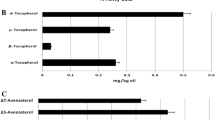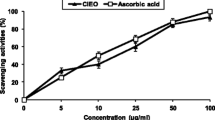Abstract
Boletus aereus Bull. is a bolete, an edible mushroom frequently consumed all over the globe as a delicate mushroom, especially in Serbia, Portugal, Basque Country, Navarre, France and Italy. B. aereus was showed to be rich in carbohydrates (82.58 g/100 g dw), followed by proteins (7.86 g/100 g dw), ash (6.20 g/100 g dw) and fat (3.36 g/100 g dw). The most abundant sugar was identified as trehalose (11.28 g/100 g dw); three tocopherol isoforms (α-, β- and δ-tocopherols) were detected. Unsaturated fatty acids predominated over saturated fatty acids, with oleic and linoleic acids as the most dominant ones. p-Hydroxybenzoic (8.95 μg/100 g dw), p-coumaric (7.32 μg/100 g dw) and cinnamic (5.91 μg/100 g dw) acids were quantified, as also four organic acids: oxalic (0.69 g/100 g dw), citric (0.59 g/100 g dw), quinic (0.34 g/100 g dw), and fumaric (0.20 g/100 g dw) acids. The mushroom methanolic extract showed in vitro antioxidant and antimicrobial activities, and successively inhibited the growth of meat contaminant bacteria, both at 25 ºC and 4 ºC, after 7 days of inoculation.
Similar content being viewed by others
References
Alves MJ, Ferreira ICFR, Dias J, Teixeira V, Martins A, Pintado M (2013) A review on antifungal activity of mushroom (basidiomycetes) extracts and isolated compounds. Curr Top Med Chem 13:2648–2659
AOAC (1995) Official methods of analysis, 16th edn. Association of Official Analytical Chemists, Arlington
Barros L, Pereira C, Ferreira ICFR (2013) Optimized analysis of organic acids in edible mushrooms from Portugal by ultra fast liquid chromatography and photodiode array detection. Food Anal Methods 6:309–316
Borch E, Arinder P (2002) Bacteriological safety issues in red meat and ready-to-eat meat products, as well as control measures. Meat Sci 62:381–390
Bukvički D, Stojković D, Soković M, Vannini L, Montanari C, Pejin B, Savic A, Veljic M, Grujic S, Marin PD (2014) Satureja horvatii essential oil: in vitro antimicrobial and antiradical properties and in situ control of Listeria monocytogenes in pork meat. Meat Sci 96:1355–1360
Carocho M, Ferreira ICFR (2013) A review on antioxidants, prooxidants and related controversy: natural and synthetic compounds, screening and analysis methodologies and future perspectives. Food Chem Toxicol 51:15–25
Cleveland J, Montville TJ, Nes IF, Chikindas ML (2001) Bacteriocins: safe, natural antimicrobials for food preservation. Int J Food Microbiol 71:1–20
CLSI. Clinical and Laboratory Standards Institute (2009) Methods for dilution antimicrobial susceptibility tests for bacteria that grow aerobically. Approved standard, 8th edn. CLSI publication M07-A8. Clinical and Laboratory Standards Institute, Wayne
Evans MR, Salmon RL, Nehaul L, Mably S, Wafford L, Nolan-Farrell MZ, Gardner D, Ribeiro CD (1999) An outbreak of Salmonella typhimurium DT170 associated with kebab meat and yogurt relish. Epidemiol Infect 122:377–383
Ferreira ICFR, Barros L, Abreu RMV (2009) Antioxidants in wild mushrooms. Curr Med Chem 16:1543–1560
Franz CMAP, Cho G-S, Holzapfel WH, Gálvez A (2010) Safety of Lactic Acid Bacteria. In: Mozzi F, Raya RR, Vignolo GM (eds) Biotechnology of Lactic Acid Bacteria: Novel Applications. Wiley, Oxford, pp 341–59
Hadžić I (2012) Priručnik za branje jestivih i lekovitih gljiva. Edicija, Belgrade, Serbia
Hanuš LO, Shkrob I, Dembitsky VM (2008) Lipids and fatty acids of wild edible mushrooms of the genus Boletus. J Food Lipids 15:370–383
Heleno SA, Barros L, Sousa MJ, Martins A, Ferreira ICFR (2009) Study and characterization of selected nutrients in wild mushrooms from Portugal by gas chromatography and high performance liquid chromatography. Microchem J 93:195–199
Heleno SA, Barros L, Sousa MJ, Martins A, Ferreira ICFR (2010) Tocopherols composition of Portuguese wild mushrooms with antioxidant capacity. Food Chem 119:1443–1450
Heleno SA, Barros L, Sousa MJ, Martins AM, Santos-Buelga C, Ferreira ICFR (2011) Targeted metabolites analysis in wild Boletus species. LWT Food Sci Technol 44:1343–1348
Hensley K, Benaksas EJ, Bolli R, Comp P, Grammas P, Hamdheydari L et al (2004) New perspectives on vitamin E: gamma-tocopherol and carboxyelthylhydroxychroman metabolites in biology and medicine. Free Radic Biol Med 36:1–15
Kalač P (2013) A review of chemical composition and nutritional value of wild-growing and cultivated mushrooms. J Sci Food Agric 93:209–218
Kris-Etherton PM (1999) Monounsaturated fatty acids and risk of cardiovascular disease. Circulation 100:1253–1258
Morris MC, Schneider JA, Li H, Tangney CC, Nag S, Bennett DA, Honer WG, Barnes LL (2014) Brain tocopherols related to Alzheimer’s disease neuropathology in humans. Alzheimers Dement S1552–5260(13):02942–7
Popović V, Živković J, Davidović S, Stevanović M, Stojković D (2013) Mycotherapy of cancer: an update on cytotoxic and antitumor activities of mushrooms, bioactive principles and molecular mechanisms of their action. Curr Top Med Chem 13:2791–2806
Reis FS, Stojković D, Soković M, Glamočlija J, Cirić A, Barros L, Ferreira ICFR (2012a) Chemical characterization of Agaricus bohusii, antioxidant potential and antifungal preserving properties when incorporated in cream cheese. Food Res Int 48:620–626
Reis FS, Martins A, Barros L, Ferreira ICFR (2012b) Antioxidant properties and phenolic profile of the most widely appreciated cultivated mushrooms: a comparative study between in vivo and in vitro samples. Food Chem Toxicol 50:1201–1207
Ren L, Perera C, Hemar Y (2012) Antitumor activity of mushroom polysaccharides: a review. Food Funct 3:1118–1130
Stojković D, Reis FS, Barros L, Glamočlija J, Cirić A, van Griensven LJLD, Soković M, Ferreira ICFR (2013a) Nutrients and non-nutrients composition and bioactivity of wild and cultivated Coprinus comatus (O.F.Müll.) Pers. Food Chem Toxicol 59:289–296
Stojković D, Reis FS, Ferreira ICFR, Barros L, Glamočlija J, Ćirić A, Nikolić M, Stević T, Giweli A, Soković M (2013b) Tirmania pinoyi: chemical composition, in vitro antioxidant and antibacterial activities and in situ control of Staphylococcus aureus in chicken soup. Food Res Int 53:56–62
Stojković DS, Barros L, Calhelha RC, Glamočlija J, Ćirić A, Van Griensven LJLD, Soković M, Ferreira ICFR (2014a) A detailed comparative study between chemical and bioactive properties of Ganoderma lucidum from different origins. Int J Food Sci Nutr 65:42–47
Stojković D, Reis FS, Glamoclija J, Ciric A, Barros L, Van Griensven LJLD, Ferreira ICFR, Sokovic M (2014b) Cultivated strains of Agaricus bisporus and A. brasiliensis: chemical characterization and evaluation of antioxidant and antimicrobial properties for final healthy product - natural preservatives in yoghurt. Food Funct 5:1602–1612
Acknowledgments
The authors are grateful to Foundation for Science and Technology (FCT, Portugal) and COMPETE/QREN/EU for financial support to CIMO strategic project PEst-OE/AGR/UI0690/2011 and L. Barros contract. The authors also thank to Serbian Ministry of Education, Science and Technological Development for financial support (grant number 173032). The authors kindly thank to Nada Lazic for the harvest of the Boletus aereus sample.
Author information
Authors and Affiliations
Corresponding authors
Additional information
Research highlights
• B. aereus was a rich source of carbohydrates and proteins.
• Oleic and linoleic acid were the main fatty acids.
• p-Coumaric, p-hydroxybenzoic, and cinnamic acids were found.
• The extract possessed antimicrobial and antioxidant activities.
• The extract regulated the growth of contaminant bacteria in meat.
Dejan S. Stojković and Filipa S. Reis contributed equally to this work.
Rights and permissions
About this article
Cite this article
Stojković, D.S., Reis, F.S., Ćirić, A. et al. Boletus aereus growing wild in Serbia: chemical profile, in vitro biological activities, inactivation and growth control of food-poisoning bacteria in meat. J Food Sci Technol 52, 7385–7392 (2015). https://doi.org/10.1007/s13197-015-1853-9
Revised:
Accepted:
Published:
Issue Date:
DOI: https://doi.org/10.1007/s13197-015-1853-9




